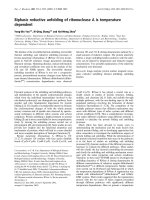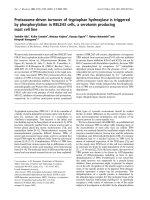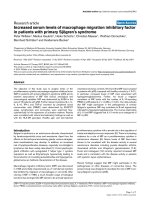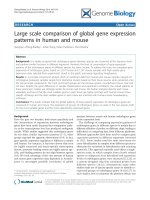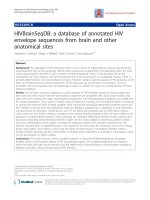Báo cáo y học: " The electronic version of this article is the complete one and can be found onlin" pot
Bạn đang xem bản rút gọn của tài liệu. Xem và tải ngay bản đầy đủ của tài liệu tại đây (1.07 MB, 2 trang )
Genome
BBiioollooggyy
2008,
99::
103
Comment
GGooiinngg ttoo tthhee ddooggss
Gregory A Petsko
Address: Rosenstiel Basic Medical Sciences Research Center, Brandeis University, Waltham, MA 02454-9110, USA.
Email:
Published: 31 March 2008
Genome
BBiioollooggyy
2008,
99::
103 (doi:10.1186/gb-2008-9-3-103)
The electronic version of this article is the complete one and can be
found online at />© 2008 BioMed Central Ltd
Owing to an imminent grant deadline, Greg Petsko is
unable to deliver his column this month. In the interest of
interspecies cooperation, his two dogs, Mink and Clifford,
have generously volunteered to take his place. For those of
you not familiar with them (they have appeared on these
pages twice before), Mink is a large chocolate labrador
retriever; Clifford is a small spaniel/poodle mixed breed. In
intelligence and character, Mink is basically a noble, albeit
constantly hungry, human being in a canine body. Clifford
is - well, a dog.
Mink: Clifford, did you see that a Hungarian scientist, one
Csaba Molnar, has been developing a computer program to
analyze dog’s barks? There’s even a paper about it (Molnar
C, et al.: Classification of dog barks: a machine learn-
ing approach. Animal Cognition 2008, doi: 10.1007/
s10071-007-0129-9).
Clifford: What does the paper say?
Mink: Here’s the abstract: “In this study we analyzed the
possible context-specific and individual-specific features of
dog barks using a new machine-learning algorithm. A pool
containing more than 6,000 barks, which were recorded in
six different communicative situations, was used as the
sound sample. The algorithm’s task was to learn which
acoustic features of the barks, which were recorded in differ-
ent contexts and from different individuals, could be distin-
guished from another. The program conducted this task by
analyzing barks emitted in previously identified contexts by
identified dogs. After the best feature set had been obtained
(with which the highest identification rate was achieved), the
efficiency of the algorithm was tested in a classification task
in which unknown barks were analyzed. The recognition
rates we found were highly above chance level: the algorithm
could categorize the barks according to their recorded situa-
tion with an efficiency of 43% and with an efficiency of 52%
of the barking individuals. These findings suggest that dog
barks have context-specific and individual-specific acoustic
features. In our opinion, this machine learning method may
provide an efficient tool for analyzing acoustic data in
various behavioral studies.”
Clifford: It says, “These findings suggest that dog barks
have context-specific…acoustic features?” You mean this is
news?? Well, I guess every person has his day.
Mink: Maybe the people who did this study had never been
owned by a dog. I mean even Greg, who’s basically clueless,
can tell the difference between a bark to come inside, a bark
when some stranger is at the door, a bark at another dog
when we’re out for a walk, or a bark with excitement when
he throws us the ball.
Clifford: Throw the ball! Throw the ball!
Mink: Calm down. The New Scientist did a short piece on
this back in January and they interviewed Dr Molnar. In the
interview he said, “In the past, scientists thought that dog
barks originated as a by-product of domestication and so
have no communicative role. But we have shown there are
contextual differences.”
Clifford: No communicative role? I mean, did they ever
listen to us? We have a very high-pitched bark when we’re in
distress; a deep, powerful almost continuous bark when
we’re warning off some intruder into our territory; well-
spaced moderately pitched barks when we want to go inside
or outside; and higher-pitched barks when we’re playing
with other dogs. The next thing you know, they’ll be “discov-
ering” that the different ways we wag our tails mean some-
thing. I’d like to meet that Dr Molnar. I have a bone to pick
with him.
Mink: So to speak.
Clifford: Did you say the computer program was right 43%
of the time? But I thought in similar studies humans were
right about 40% of the time. Even Greg’s right almost half
the time.
Mink: Yes, I don’t understand why they made a big deal
about this. I mean, there’s no significant difference between
43% and 40%.
Clifford: If they think this is a big improvement, they’re
barking up the wrong tree.
Mink: Uh, yes, as it were.
Clifford: But I don’t understand what this has to do with
this month’s column.
Mink: By this point, neither do our readers, I suspect. But
here’s what I think we should tell them. I think we should
tell them that what is really needed is a way to help scientists
understand not dogs, but each other.
Clifford: Now I’m the one who’s not understanding.
Mink: What I mean is that Greg is always complaining that
chemists can’t understand one another because the physical
chemists speak a different jargon from synthetic organic
chemists and so on. And he says that biologists are better off
because most biologists can go to any talk by any other biolo-
gist, whether they are a structural biologist or a cell biologist
or a geneticist or an immunologist or a genome scientist, and
understand most of what’s being said. They can go to any
biology conference and have a ball.
Clifford: Ball?? Throw the ball! Throw the ball!!
Mink: For Pete’s sake, get a grip. Anyway, I think that
Greg’s forgotten something very important. He’s forgotten
that in the age of genomics, when biology is becoming more
quantitative and depending more and more on new tech-
niques and tools that must come from the physical sciences,
the real problem is that most biologists can’t understand
chemists and physicists and hardly any chemists and physi-
cists know what to make of the typical biology seminar, with
its lists of gene names and gel slides and acronyms that don’t
stand for anything sensible.
Clifford: Are you saying there should be a computer
program that would translate jargon from one field of
science into another?
Mink: Now that would be worth developing. If you couldn’t
use it at a research talk, at least it could be used to translate
papers. Maybe Dr Molnar ought to work on that idea. But I
doubt we’ll see it any time soon. I’m not even sure it’s what’s
most needed. Unless you’re a chemist or physicist who wants
to become a biologist, or vice versa, the real issue is not
whether you can understand a seminar in some other field,
it’s knowing what applications of your field would make a big
impact on that one.
Clifford: You mean knowing what the big important prob-
lems are?
Mink: Exactly. And what new tools or methods are needed
to solve them. So here’s a simple idea: At every big meeting
of the American Chemical Society and the American Physical
Society and so forth, there ought to be a special plenary
lecture by a biologist, one who’s really good at explaining
things. The lecture ought to start with an introduction to
some important area of biology and end with a list of some of
the major outstanding problems in that area and what sort
of things would help get them solved. That way, people from
other disciplines who might have new ideas or who would be
interested in developing new methods would know what was
needed. I bet at least a few of them would get excited about
it, too, every time.
Clifford: That’s a very good idea. Greg ought to put it in one
of his columns.
Mink: I think we just did that for him. To be honest, I don’t
think Greg has much chance of getting this to happen, but I
hope I’m wrong. You know how I like to root for the under-man.
Clifford: Well, I’m just a puppy, but it seems to me that the
Molnar business you started this column with is a classic
case of the tail wagging the person. I mean, the solution to
understanding us dogs isn’t some computer program. All
people need to do is just pay attention and listen more. But I
suppose that’s too much to expect.
Mink: Don’t be too hard on them. After all, they’re only
human.
/>Genome
BBiioollooggyy
2008, Volume 9, Issue 3, Article 103 Petsko 103.2
Genome
BBiioollooggyy
2008,
99::
103
FFiigguurree 11
Mink and Clifford are dog-tired, so they take a well-deserved rest after
substituting for Greg Petsko in this month’s column.
